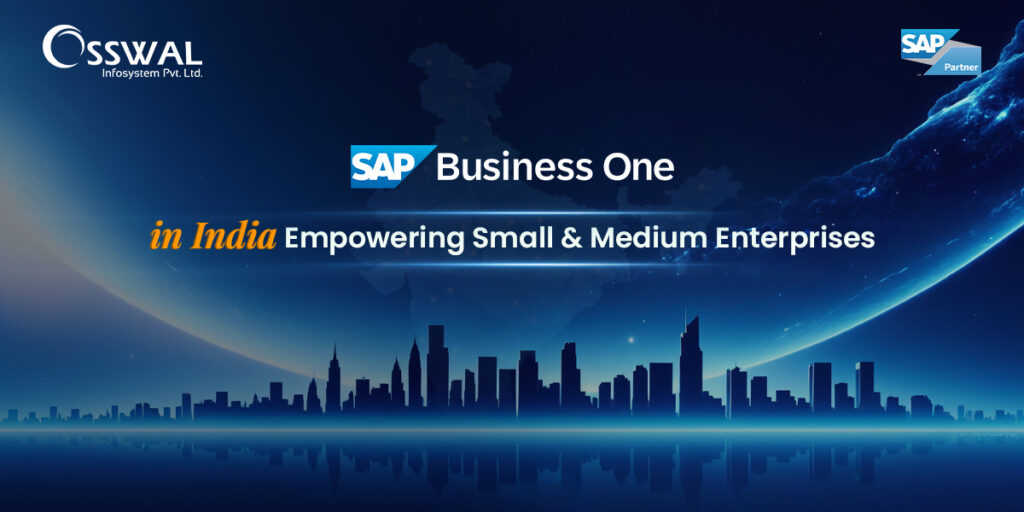SAP Business One in India: Empowering Small and Medium Enterprises Nowadays, in a competitive market, businesses are continually seeking ways to simplify their operations, reduce expenses, and increase productivity. SAP Business One in India empowers ESHs to make their wish come true. Additionally, SAP B1, as a unified ERP (Enterprise Resource Planning) system, facilitates companies in carrying out accounting, sales, warehousing, and customer relationship management all through a single platform. Osswal Infosystem, a reliable SAP partner in India, comes up with personalized SAP Business One solutions for Indian businesses having a distinct work culture. Why Indian SMEs Choose SAP Business One Small and medium enterprises (SMEs) are the backbone of India’s economy, but many of them suffer from fragmented processes and manual operations. SAP Business One provides them with an all-in-one solution to their problems. In this way, companies improve their data to decrease their operational costs and empower managers to make the right calls through up-to-the-minute data. For example, finance teams will be able to do the paperwork in no time, whereas sales and inventory teams will have access to the performance of each market. Moreover, the modular structure of SAP B1 enables SMEs to easily extend their business operations as their company grows. Osswal Infosystem makes sure that Indian SMEs receive the perfect solution that matches their industry needs, providing local expertise and support. Key Features of SAP Business One SAP B1 comes with a range of features that make it ideal for businesses in India: Financial Management: Provides the tools to automate accounting, banking, and financial reporting activities, thereby increasing accuracy and compliance. Sales and Customer Management: Keeps track of customer relationships, sales orders, and the company’s services after the sale. Inventory and Production Control: Keeps track of inventory levels, organizes purchasing, and follows the progress of production. Business Intelligence: Offers the potential for a wide range of business decisions by providing real-time insights with dashboards and analytics. Mobile Access: The opportunity for executives and employees to obtain business information anytime and anywhere, thus improving responsiveness. Benefits of Implementing SAP Business One in India In India, the benefits of implementing SAP Business One are not limited to the process of automation. A lot of organizations have stated that it has enabled them to operate more efficiently, which has also allowed for better communication between the different departments and quicker decision-making. One of the many advantages that come with the use of an integrated ERP is that it not only reduces mistakes but also raises the level of transparency. Moreover, the software also supports businesses in meeting the regulatory standards that are constantly changing in India, for example, the GST report and statutory audits. Through on-the-spot reporting and analytics, management can quickly spot patterns and make decisions that are based on the data. Osswal Infosystem helps its clients through the entire implementation phase, starting from the planning and customization stages to the training and ongoing support for ensuring a successful transition to SAP B1. Industry Applications of SAP Business One SAP B1 can be adapted to suit the needs of a large number of industries in India, such as manufacturing, retail, wholesale distribution, and services etc. The software in manufacturing is performing the tasks of the control of production scheduling, managing raw materials, and ensuring product quality assurance. In retail, the solution is monitoring sales, stock levels, and customer preferences, which results in customer satisfaction. On the flip side, service companies can use SAP Business One to monitor project status, assign resources, and streamline billing. Osswal Infosystem has deployed SAP B1 across multiple industrial sectors with great success, contributing to the rise of enterprises that are able to drive operational excellence and secure sustainable growth. Why Choose Osswal Infosystem as Your SAP Partner Finding the right SAP partner can make or break the whole ERP implementation. Osswal Infosystem is the top in India as it has the deep expertise of SAP Business One, the strong Customer support that the company is known for, and the commitment to providing solutions that are tailored to the needs of the client. The Osswal Infosystem team, in conjunction with the SAP B1 deployment strategy, ensures that businesses have growth opportunities by turning the system into their arsenal. Part of their method is to get the customer’s requirements, customize the software according to the local business norms, and offer uninterrupted support. This on-site approach significantly reduces interruptions and turns the ERP system into the company’s success driver rather than a management problem Conclusion For Indian SMEs aiming to optimize operations, enhance productivity, and achieve scalable growth, SAP Business One in India offers a reliable, integrated ERP solution. Supported by Osswal Infosystem as a reliable partner, helps enterprises implement SAP B1 swiftly and smoothly to reap the benefits of the versatile suite, from financial management to business intelligence. Purchasing SAP B1 is a pact with one’s business to make smarter decisions, achieve higher efficiency, and maintain their competitive edge in the market.
SAP Business One in India: Empowering Small and Medium Enterprises Read More »










